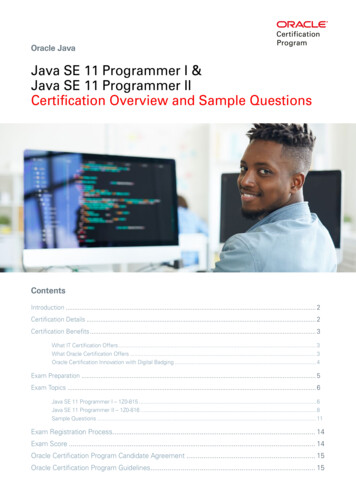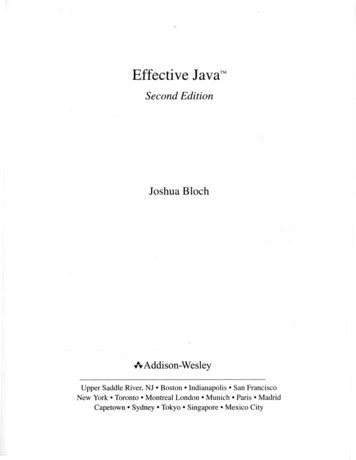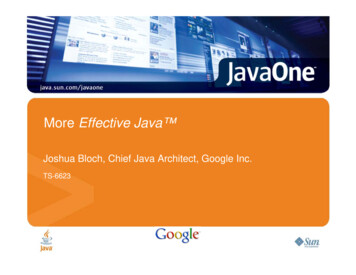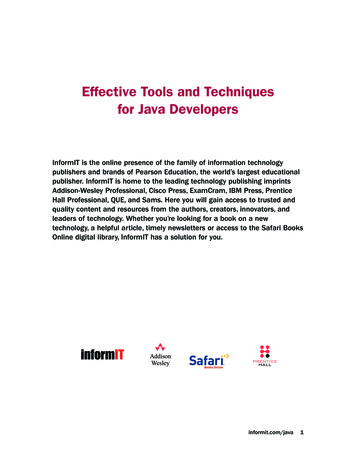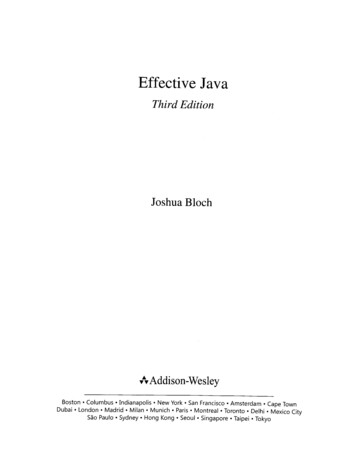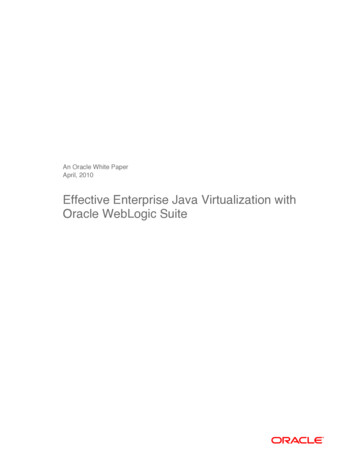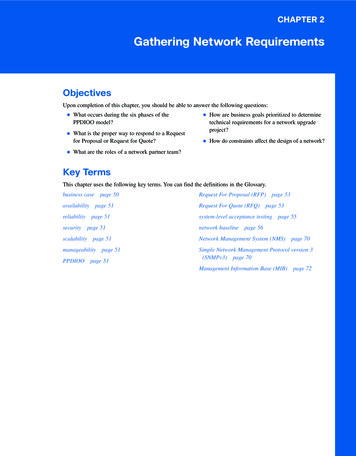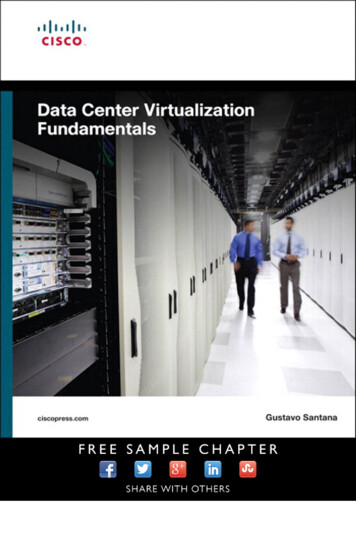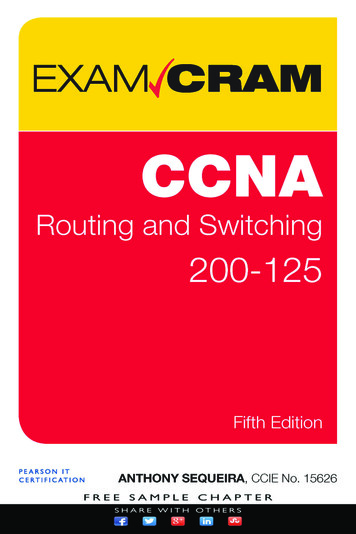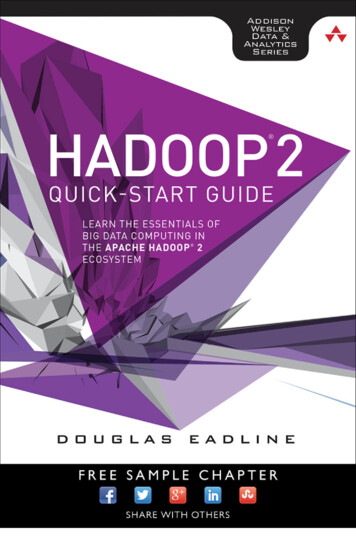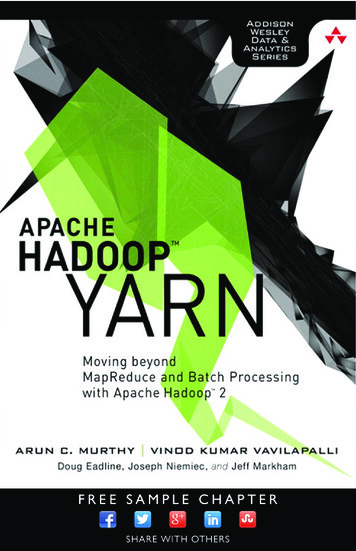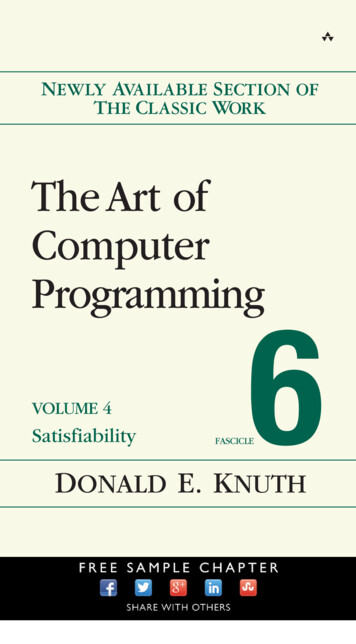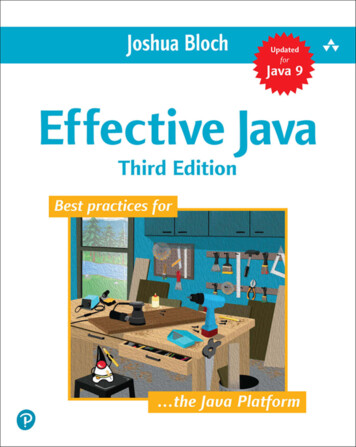
Transcription
Effective JavaThird Edition
This page intentionally left blank
Effective JavaThird EditionJoshua BlochBoston Columbus Indianapolis New York San Francisco Amsterdam Cape TownDubai London Madrid Milan Munich Paris Montreal Toronto Delhi Mexico CitySão Paulo Sydney Hong Kong Seoul Singapore Taipei Tokyo
Many of the designations used by manufacturers and sellers to distinguish their products are claimed astrademarks. Where those designations appear in this book, and the publisher was aware of a trademarkclaim, the designations have been printed with initial capital letters or in all capitals.The author and publisher have taken care in the preparation of this book, but make no expressed or impliedwarranty of any kind and assume no responsibility for errors or omissions. No liability is assumed forincidental or consequential damages in connection with or arising out of the use of the information orprograms contained herein.For information about buying this title in bulk quantities, or for special sales opportunities (which mayinclude electronic versions; custom cover designs; and content particular to your business, traininggoals, marketing focus, or branding interests), please contact our corporate sales department atcorpsales@pearsoned.com or (800) 382-3419.For government sales inquiries, please contact governmentsales@pearsoned.com.For questions about sales outside the U.S., please contact intlcs@pearson.com.Visit us on the Web: informit.com/awLibrary of Congress Control Number: 2017956176Copyright 2018 Pearson Education Inc.Portions copyright 2001-2008 Oracle and/or its affiliates.All Rights Reserved.All rights reserved. Printed in the United States of America. This publication is protected by copyright, andpermission must be obtained from the publisher prior to any prohibited reproduction, storage in a retrievalsystem, or transmission in any form or by any means, electronic, mechanical, photocopying, recording, orlikewise. For information regarding permissions, request forms and the appropriate contacts within thePearson Education Global Rights & Permissions Department, please visitwww.pearsoned.com/permissions/.ISBN-13: 978-0-13-468599-1ISBN-10: 0-13-468599-71 17
To my family: Cindy, Tim, and Matt
This page intentionally left blank
ContentsForeword . . . . . . . . . . . . . . . . . . . . . . . . . . . . . . . . . . . . . . . . . . . . . . xiPreface . . . . . . . . . . . . . . . . . . . . . . . . . . . . . . . . . . . . . . . . . . . . . . . xiiiAcknowledgments . . . . . . . . . . . . . . . . . . . . . . . . . . . . . . . . . . . . xvii1 Introduction . . . . . . . . . . . . . . . . . . . . . . . . . . . . . . . . . . . . . . . . . 12 Creating and Destroying Objects . . . . . . . . . . . . . . . . . . . . . 5Item 1: Consider static factory methods instead of constructors . . . 5Item 2: Consider a builder when faced with many constructorparameters . . . . . . . . . . . . . . . . . . . . . . . . . . . . . . . . . . . . . 10Item 3: Enforce the singleton property with a private constructoror an enum type . . . . . . . . . . . . . . . . . . . . . . . . . . . . . . . . . 17Item 4: Enforce noninstantiability with a private constructor . . . . 19Item 5: Prefer dependency injection to hardwiring resources . . . . 20Item 6: Avoid creating unnecessary objects . . . . . . . . . . . . . . . . . 22Item 7: Eliminate obsolete object references . . . . . . . . . . . . . . . . . 26Item 8: Avoid finalizers and cleaners . . . . . . . . . . . . . . . . . . . . . . 29Item 9: Prefer try-with-resources to try-finally . . . . . . . . . . . . 343 Methods Common to All Objects . . . . . . . . . . . . . . . . . . . . 37Item 10: Obey the general contract when overriding equals . . . . .Item 11: Always override hashCode when you override equals . .Item 12: Always override toString . . . . . . . . . . . . . . . . . . . . . . . .Item 13: Override clone judiciously . . . . . . . . . . . . . . . . . . . . . . . .Item 14: Consider implementing Comparable . . . . . . . . . . . . . . . .37505558664 Classes and Interfaces . . . . . . . . . . . . . . . . . . . . . . . . . . . . . . . 73Item 15: Minimize the accessibility of classes and members . . . . .Item 16: In public classes, use accessor methods, not public fieldsItem 17: Minimize mutability . . . . . . . . . . . . . . . . . . . . . . . . . . . . .Item 18: Favor composition over inheritance . . . . . . . . . . . . . . . . .73788087vii
viiiCONTENTSItem 19: Design and document for inheritance or else prohibit it 93Item 20: Prefer interfaces to abstract classes . . . . . . . . . . . . . . . . . 99Item 21: Design interfaces for posterity . . . . . . . . . . . . . . . . . . . . 104Item 22: Use interfaces only to define types. . . . . . . . . . . . . . . . . 107Item 23: Prefer class hierarchies to tagged classes . . . . . . . . . . . . 109Item 24: Favor static member classes over nonstatic . . . . . . . . . . 112Item 25: Limit source files to a single top-level class . . . . . . . . . 1155 Generics . . . . . . . . . . . . . . . . . . . . . . . . . . . . . . . . . . . . . . . . . . . 117Item 26: Don’t use raw types . . . . . . . . . . . . . . . . . . . . . . . . . . . .Item 27: Eliminate unchecked warnings. . . . . . . . . . . . . . . . . . . .Item 28: Prefer lists to arrays . . . . . . . . . . . . . . . . . . . . . . . . . . . .Item 29: Favor generic types. . . . . . . . . . . . . . . . . . . . . . . . . . . . .Item 30: Favor generic methods . . . . . . . . . . . . . . . . . . . . . . . . . .Item 31: Use bounded wildcards to increase API flexibility . . . .Item 32: Combine generics and varargs judiciously. . . . . . . . . . .Item 33: Consider typesafe heterogeneous containers . . . . . . . . .1171231261301351391461516 Enums and Annotations . . . . . . . . . . . . . . . . . . . . . . . . . . . 157Item 34: Use enums instead of int constants. . . . . . . . . . . . . . . .Item 35: Use instance fields instead of ordinals . . . . . . . . . . . . . .Item 36: Use EnumSet instead of bit fields . . . . . . . . . . . . . . . . . .Item 37: Use EnumMap instead of ordinal indexing. . . . . . . . . . . .Item 38: Emulate extensible enums with interfaces . . . . . . . . . . .Item 39: Prefer annotations to naming patterns . . . . . . . . . . . . . .Item 40: Consistently use the Override annotation. . . . . . . . . . .Item 41: Use marker interfaces to define types . . . . . . . . . . . . . .1571681691711761801881917 Lambdas and Streams . . . . . . . . . . . . . . . . . . . . . . . . . . . . . 193Item 42: Prefer lambdas to anonymous classes . . . . . . . . . . . . . .Item 43: Prefer method references to lambdas . . . . . . . . . . . . . . .Item 44: Favor the use of standard functional interfaces . . . . . . .Item 45: Use streams judiciously . . . . . . . . . . . . . . . . . . . . . . . . .Item 46: Prefer side-effect-free functions in streams . . . . . . . . . .Item 47: Prefer Collection to Stream as a return type. . . . . . . . . .Item 48: Use caution when making streams parallel . . . . . . . . . .193197199203210216222
CONTENTS8 Methods . . . . . . . . . . . . . . . . . . . . . . . . . . . . . . . . . . . . . . . . . . 227Item 49: Check parameters for validity . . . . . . . . . . . . . . . . . . . . .Item 50: Make defensive copies when needed . . . . . . . . . . . . . . .Item 51: Design method signatures carefully . . . . . . . . . . . . . . . .Item 52: Use overloading judiciously . . . . . . . . . . . . . . . . . . . . . .Item 53: Use varargs judiciously . . . . . . . . . . . . . . . . . . . . . . . . . .Item 54: Return empty collections or arrays, not nulls . . . . . . . . .Item 55: Return optionals judiciously . . . . . . . . . . . . . . . . . . . . . .Item 56: Write doc comments for all exposed API elements . . . .2272312362382452472492549 General Programming . . . . . . . . . . . . . . . . . . . . . . . . . . . . 261Item 57: Minimize the scope of local variables . . . . . . . . . . . . . . .Item 58: Prefer for-each loops to traditional for loops . . . . . . . . .Item 59: Know and use the libraries . . . . . . . . . . . . . . . . . . . . . . .Item 60: Avoid float and double if exact answers are required .Item 61: Prefer primitive types to boxed primitives . . . . . . . . . . .Item 62: Avoid strings where other types are more appropriate . .Item 63: Beware the performance of string concatenation . . . . . .Item 64: Refer to objects by their interfaces . . . . . . . . . . . . . . . . .Item 65: Prefer interfaces to reflection . . . . . . . . . . . . . . . . . . . . .Item 66: Use native methods judiciously. . . . . . . . . . . . . . . . . . . .Item 67: Optimize judiciously . . . . . . . . . . . . . . . . . . . . . . . . . . . .Item 68: Adhere to generally accepted naming conventions . . . . .26126426727027327627928028228528628910 Exceptions . . . . . . . . . . . . . . . . . . . . . . . . . . . . . . . . . . . . . . . . 293Item 69: Use exceptions only for exceptional conditions . . . . . . .Item 70: Use checked exceptions for recoverable conditions andruntime exceptions for programming errors . . . . . . . . . .Item 71: Avoid unnecessary use of checked exceptions . . . . . . . .Item 72: Favor the use of standard exceptions. . . . . . . . . . . . . . . .Item 73: Throw exceptions appropriate to the abstraction. . . . . . .Item 74: Document all exceptions thrown by each method. . . . . .Item 75: Include failure-capture information in detail messages. .Item 76: Strive for failure atomicity . . . . . . . . . . . . . . . . . . . . . . .Item 77: Don’t ignore exceptions . . . . . . . . . . . . . . . . . . . . . . . . .293296298300302304306308310ix
xCONTENTS11 Concurrency . . . . . . . . . . . . . . . . . . . . . . . . . . . . . . . . . . . . . . 311Item 78: Synchronize access to shared mutable data . . . . . . . . . .Item 79: Avoid excessive synchronization . . . . . . . . . . . . . . . . . .Item 80: Prefer executors, tasks, and streams to threads . . . . . . .Item 81: Prefer concurrency utilities to wait and notify . . . . . .Item 82: Document thread safety . . . . . . . . . . . . . . . . . . . . . . . . .Item 83: Use lazy initialization judiciously . . . . . . . . . . . . . . . . .Item 84: Don’t depend on the thread scheduler . . . . . . . . . . . . . .31131732332533033333612 Serialization . . . . . . . . . . . . . . . . . . . . . . . . . . . . . . . . . . . . . . . 339Item 85: Prefer alternatives to Java serialization . . . . . . . . . . . . .Item 86: Implement Serializable with great caution . . . . . . . .Item 87: Consider using a custom serialized form . . . . . . . . . . . .Item 88: Write readObject methods defensively . . . . . . . . . . . .Item 89: For instance control, prefer enum types toreadResolve . . . . . . . . . . . . . . . . . . . . . . . . . . . . . . . . .Item 90: Consider serialization proxies instead of serializedinstances . . . . . . . . . . . . . . . . . . . . . . . . . . . . . . . . . . . . .339343346353359363Items Corresponding to Second Edition . . . . . . . . . . . . . . . 367References . . . . . . . . . . . . . . . . . . . . . . . . . . . . . . . . . . . . . . . . . . . . 371Index . . . . . . . . . . . . . . . . . . . . . . . . . . . . . . . . . . . . . . . . . . . . . . . . 377
ForewordIF a colleague were to say to you, “Spouse of me this night today manufactures theunusual meal in a home. You will join?” three things would likely cross your mind:third, that you had been invited to dinner; second, that English was not your colleague’s first language; and first, a good deal of puzzlement.If you have ever studied a second language yourself and then tried to use itoutside the classroom, you know that there are three things you must master: howthe language is structured (grammar), how to name things you want to talk about(vocabulary), and the customary and effective ways to say everyday things(usage). Too often only the first two are covered in the classroom, and you findnative speakers constantly suppressing their laughter as you try to make yourselfunderstood.It is much the same with a programming language. You need to understand thecore language: is it algorithmic, functional, object-oriented? You need to know thevocabulary: what data structures, operations, and facilities are provided by thestandard libraries? And you need to be familiar with the customary and effectiveways to structure your code. Books about programming languages often coveronly the first two, or discuss usage only spottily. Maybe that’s because the firsttwo are in some ways easier to write about. Grammar and vocabulary are properties of the language alone, but usage is characteristic of a community that uses it.The Java programming language, for example, is object-oriented with singleinheritance and supports an imperative (statement-oriented) coding style withineach method. The libraries address graphic display support, networking, distributed computing, and security. But how is the language best put to use in practice?There is another point. Programs, unlike spoken sentences and unlike mostbooks and magazines, are likely to be changed over time. It’s typically not enoughto produce code that operates effectively and is readily understood by other persons; one must also organize the code so that it is easy to modify. There may beten ways to write code for some task T. Of those ten ways, seven will be awkward,inefficient, or puzzling. Of the other three, which is most likely to be similar to thecode needed for the task T' in next year’s software release?xi
xiiFOREWORDThere are numerous books from which you can learn the grammar of the Javaprogramming language, including The Java Programming Language by Arnold,Gosling, and Holmes, or The Java Language Specification by Gosling, Joy, yourstruly, and Bracha. Likewise, there are dozens of books on the libraries and APIsassociated with the Java programming language.This book addresses your third need: c
associated with the Java programming language. This book addresses your third need: customary and effective usage. Joshua Bloch has spent years extending File Size: 524KBPage Count: 77
